

本文通过聚焦作者的电影作品《地层2: 软流层》, 再度拆解和阐释了音乐在电影中的作用及其作用方式。电影的声响空间强调了创作者和观众与现实的距离, 由此构建了一个由“社会复眼”和“社会复耳”组成的感知和抓取体系, 反映出对现实的整体观察, 其中, 声音是主导性力量。作者详细介绍了其在实践过程中使用的音乐类别及工作方法, 认为这是一个通过作者的身体感知、与设想不同、慢慢变形的空间, 在电影的内部与外部各种电影力量相互作用, 即不同媒介材料之间的蒙太奇, 从而生成并激活了新的意义。作者总结了影片中的四种音乐模式: 水平/垂直的音乐、植物性/动物性的音乐、描述性/间离性的音乐、战争-影像/音乐, 并进一步关注作者的创作经验与作 品内部之间的蒙太奇关系。最后, 本文将电影比作驱魔仪式的剧场, 并提出了日常生活中的“幽灵”该如何处理的开放性问题。
This article deconstructs and reinterprets the role and function of music in film by focusing on the author’s practice Stratum 2: Asthenosphere. The sonic space in the film emphasizes the distance from the creator and audience to reality, thereby constructing a perceptual system and integrating the “social compound eye” and “social compound ear”, reflecting a holistic observation of reality where sound plays a dominant role. The author provides a detailed introduction to the types of music used and the working methods employed in the practice, viewing this as a space shaped by the creator’s bodily perception, one that diverges from initial expectations and gradually transforms. Within the film, various cinematic forces, both internal and external, interact, through the montage of diverse media materials, which produces and activates new meanings. The author summarizes four musical modes in the film: horizontal/vertical music, botanical/ animalistic music, descriptive/alienating music, and war-image/music integration. Furthermore, attention is given to the montage relationship between the author’s creative experience and the interaction within the work itself. Lastly, the article likens the film to a theater of exorcism and raises the open-ended question of how to deal with the phantom of everyday life.